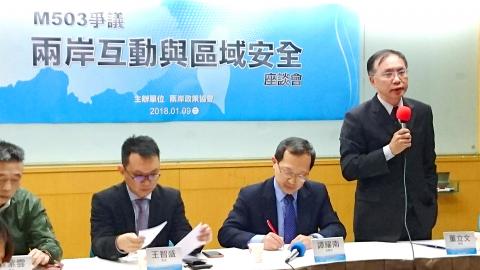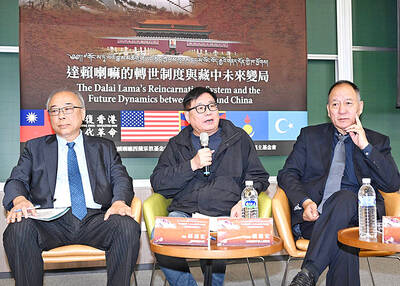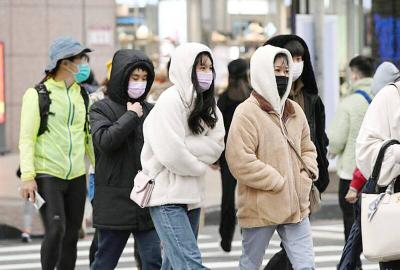China’s move to launch northbound commercial flights on the M503 route compromises the integrity of Taiwan’s airspace, and the nation should reduce cross-strait flights to force negotiations with China while increasing its defense budget and develop asymmetric defense capabilities, academics said yesterday.
China on Thursday last week unilaterally announced the launch of the M503 route, which is 7.8km from the median line of the Taiwan Strait, as well as three extension routes — W121, W122 and W123 — along the southeast coast of China.
China first introduced the M503 route in January 2015 to ease congestion in a nearby route, but its implications on Taiwan’s air defense resulted in one of the most notable cross-strait confrontations of former president Ma Ying-jeou’s (馬英九) term.

Photo: Chung Li-hua, Taipei Times
Following negotiations, southbound flights on the M503 route were launched in March 2015.
An immediate effect of Beijing’s latest move is increased difficulty in identifying military aircraft from commercial planes flying over the Strait, giving Taiwan less time to react to a military threat, Tamkang University Center of Advanced Technology executive director Su Tzu-yun (蘇紫雲) told a news conference held by the Cross-Strait Policy Association.
The Soviet Union in 1983 mistook a South Korean commercial jet that intruded into its air space for a US spy plane and shot it down, and a Malaysia Airlines plane was shot down over Ukraine in 2014, Su said.
Without communication with China, there is a possibility of misidentification, as more than 1.5 million flights traverse Taiwan’s airspace annually, he said.
Furthermore, an airstrike can be launched using a commercial flight route, as was done by Israel in Operation Entebbe in Uganda in 1976 and in Operation Opera in Iraq in 1981, Su said.
To force China into resuming negotiations with Taiwan, Taipei can reduce the number of cross-strait flights, Su said.
The M503 route’s launch is part of China’s “legal warfare,” and Taiwan needs to employ new legal narratives and drop terms formulated under the “one China” framework, Su said.
“The median line of the Taiwan Strait is a term from the [Chinese] Civil War. The narrative has to be revised using the concept of territorial waters and airspace to be convincing on an international level,” Su said.
In addition to the M503 route, “China keeps testing maritime law enforcement in Japanese, South Korean and Taiwanese waters to challenge the ‘status quo’ and create a new ‘status quo,’ which is part of China’s regional strategy,” association secretary-general Wang Zhin-sheng (王智盛) said.
China’s unilateral action provoked a rare criticism from the US Department of State, association president Stephen Tan (譚耀南) said, urging China to return to the negotiation table with Taiwan to discuss aviation safety issues.
Taiwan Thinktank consultant Tung Li-wen (董立文) urged the government to increase defense spending to 3 percent of GDP to purchase the weapons needed to build asymmetric warfare capabilities.
The Chinese aircraft carrier Liaoning sailing around Taiwan’s territorial waters is a test of China’s naval capability to break through the first island chain, and Taiwan should stay prepared, Tung said.
To maximize asymmetric defense capabilities with minimal costs, the military can develop low-cost mobile missile systems or patrol boats armed with advanced missiles, Su said, adding that some nations have developed missile systems that could be fitted on container trucks.

ALIGNED THINKING: Taiwan and Japan have a mutual interest in trade, culture and engineering, and can work together for stability, Cho Jung-tai said Taiwan and Japan are two like-minded countries willing to work together to form a “safety barrier” in the Indo-Pacific region, Premier Cho Jung-tai (卓榮泰) yesterday said at the opening ceremony of the 35th Taiwan-Japan Modern Engineering and Technology Symposium in Taipei. Taiwan and Japan are close geographically and closer emotionally, he added. Citing the overflowing of a barrier lake in the Mataian River (馬太鞍溪) in September, Cho said the submersible water level sensors given by Japan during the disaster helped Taiwan monitor the lake’s water levels more accurately. Japan also provided a lot of vaccines early in the outbreak of the COVID-19 pandemic,

Kaohsiung Mayor Chen Chi-mai (陳其邁) on Monday announced light shows and themed traffic lights to welcome fans of South Korean pop group Twice to the port city. The group is to play Kaohsiung on Saturday as part of its “This Is For” world tour. It would be the group’s first performance in Taiwan since its debut 10 years ago. The all-female group consists of five South Koreans, three Japanese and Tainan’s Chou Tzu-yu (周子瑜), the first Taiwan-born and raised member of a South Korean girl group. To promote the group’s arrival, the city has been holding a series of events, including a pop-up

TEMPORAL/SPIRITUAL: Beijing’s claim that the next Buddhist leader must come from China is a heavy-handed political maneuver that will fall flat-faced, experts said China’s requirement that the Dalai Lama’s reincarnation to be born in China and approved by Beijing has drawn criticism, with experts at a forum in Taipei yesterday saying that if Beijing were to put forth its own Dalai Lama, the person would not be recognized by the Tibetan Buddhist community. The experts made a remarks at the two-day forum hosted by the Tibet Religious Foundation of His Holiness the Dalai Lama titled: “The Snow Land Forum: Finding Common Ground on Tibet.” China says it has the right to determine the Dalai Lama’s reincarnation, as it claims sovereignty over Tibet since ancient times,

Temperatures in some parts of Taiwan are expected to fall sharply to lows of 15°C later this week as seasonal northeasterly winds strengthen, the Central Weather Administration (CWA) said today. It is to be the strongest cold wave to affect northern Taiwan this autumn, while Chiayi County in the southwest and some parts of central Taiwan are likely to also see lower temperatures due to radiational cooling, which occurs under conditions of clear skies, light winds and dry weather, the CWA said. Across Taiwan, temperatures are to fall gradually this week, dropping to 15°C to 16°C in the early hours of Wednesday